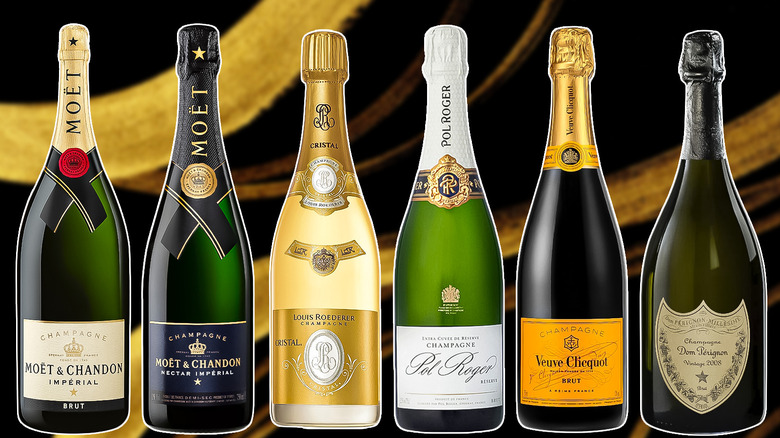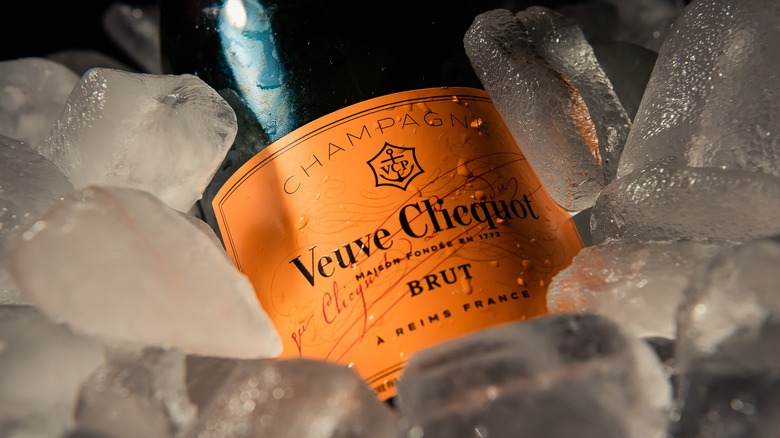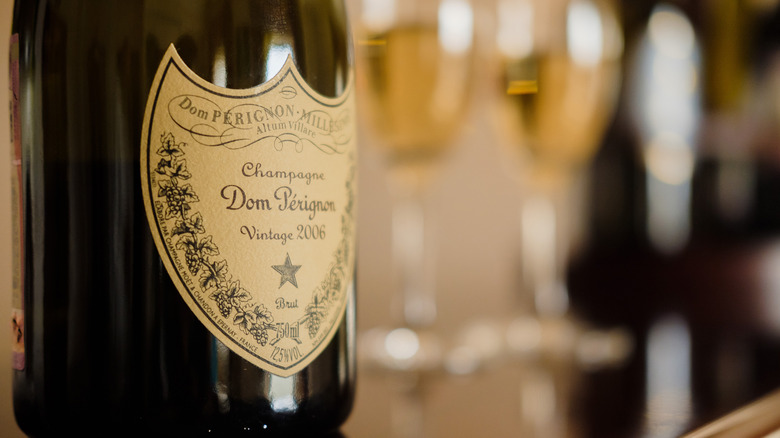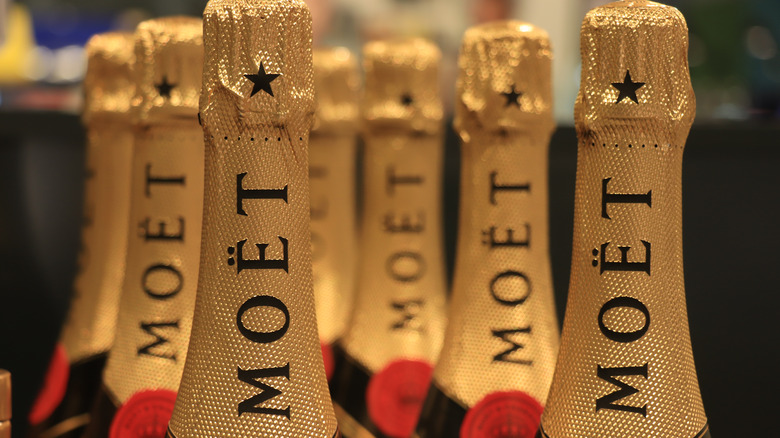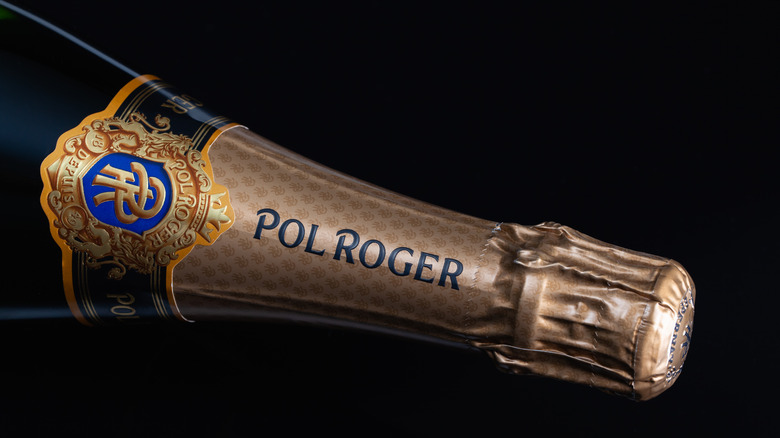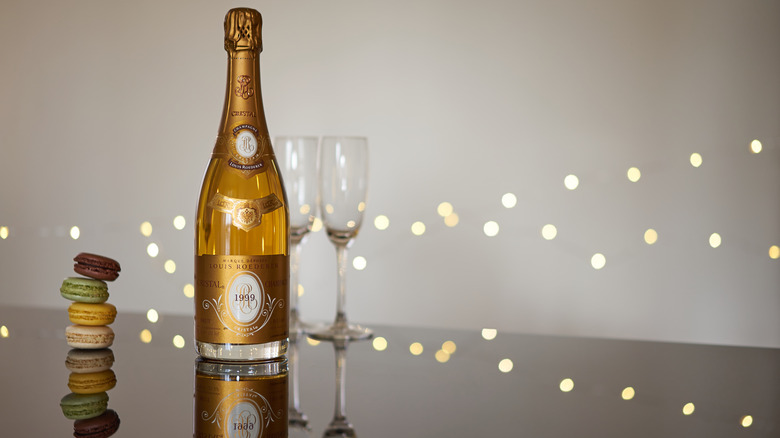The Meanings Behind Popular Champagne Names
You know you're a titan in your industry when you're known by your first name, like when a Dom or Veuve is ordered at the bar. Champagnes like these are darlings in a multi-billion-dollar industry synonymous with glamour and frivolity, though the backbone of how Champagne got its start is exactly the opposite of all that. The battle to build the Champagne industry as we know it today was tough. Before Avenue de Champagne became famous and Épernay became a most charming tourist hub, the hills of Champagne were pummeled by one land grab and bloody battle after another.
In its early years, as folklore tells it, the Champagne district was forced to rip out its vineyards in favor of harvesting grain for the food crisis that Mount Vesuvius caused for Rome. Years later, Attila the Hun came for blood and more but was crushed for the first (and only) time on the plains of Champagne. This is the historical heritage of Champagne, plagued as the land was by one invasion after another until World War I nearly decimated Reims at its vineyard roots full stop.
Sound like riveting stuff? Maybe, but chatting up these kinds of backstories gets dry fast in casual conversation among friends. Want a way to discuss the sweeping saga without your buddies stifling a yawn? Stick with the names of your favorite Champagnes. The names themselves reveal the gravitas of the Champagne story without a long, dusty lesson.
Veuve Clicquot
Did you know the "veuve" in Veuve Clicquot is French for "widow?" And there's a fascinating history behind the untold truth of Veuve Clicquot. Barbe-Nicole Clicquot, widowed by the time she was 27 years old, saved the family wine business by smuggling her Champagne across Napoleonic War-blockaded borders. It was a last-ditch effort after she had already gone to her father-in-law twice for help and put up her inheritance as collateral to bail out the failing wine label.
As the war came to a close, Barbe-Nicole managed to secretly ship copious amounts of her 1811 vintage to St. Petersburg, positioning her Champagne to reach post-war Russia weeks ahead of everyone else. Her audacious move paid off. The newly lucrative Russian market loved her wine, and Clicquot's popularity skyrocketed. To meet the new sales demands, Barbe-Nicole's team was said to have drilled (or "riddled") her table with holes so they could store Champagne bottles upside down and turn them at an angle throughout the fermenting process. The system was a precursor to the riddling rack, still used in winemaking today, which funnels sediment into the neck of a wine bottle for easy straining.
In her later years, Barbe-Nicole wrote to her great-grandchild, "The world is in perpetual motion, and we must invent the things of tomorrow," and that one should "act with audacity." Madam Barbe-Nicole Ponsardin Clicquot certainly did just that.
Dom Pérignon
Why does the first part of this famous vintage-only Champagne's name start with "Dom?" That's due to the little-known fact that its inventor, Pierre Pérignon, was a monk.
The ecclesiastical honorific "Dom" was used for prominent Benedictine monks, and Dom Pérignon assumed this role at the Abbey of Hautvillers starting in 1668. His monastery needed cash to refurbish its charred buildings, nearly flattened by the wartime mayhem that held Champagne in its grips over the first half of the 17th century. With peace finally reigning across the land, Dom Pérignon got to work cleaning up the Abbey's vineyards in order to make some money.
Pérignon had a lot going against him, not least the fact that — although bubbles may be synonymous with the invention of Champagne – they were actually detested in wine back then. Pérignon worked tirelessly to make his wine sit still, and a good many myths around his discovery of sparkling wine owe more to propaganda than historical fact. However, Pérignon's pruning practices, his habit of tossing aside broken grapes in favor of using only the most pristine grapes for the harvest, and his technique of making white wine from red wine grapes made hugely significant advances in winemaking.
Moët & Chandon
Moët & Chandon is one of the largest Champagne producers in all of France, but the name "Moët" is Dutch, so pronounce it with a hard "t," if you please. It is moh-et, as in Claude Moët, who launched Moët et Cie in 1743. 50 years later, Moët's grandson, Jean-Rémy — who was personally chummy with Napoleon Bonaparte — took over the family business. Jean-Rémy's connection to Napoleon opened doors for Moët to become a favorite among the upper echelon and French nobility of the day — so much so that its notable Moët Imperial was named for Napoleon's birthday centennial.
The Champagne house added the name "Chandon" in 1833 when Pierre-Gabriel Chandon married Jean-Rémy's daughter. A century after that, in 1927, Chandon's grandson married Francine Durant-Mercier, a significant match since the Mercier Champagne house owned patented rights to use the name of one deceased winemaker whose name was synonymous with quality wine — none other than Dom Pérignon. Eugène Mercier gifted the rights to the Dom Pérignon name over to the Moët & Chandon family in honor of his granddaughter's wedding.
Interestingly, Pérignon's wine in his day was touted as the vins de Pérignon, rather than a product of his Abbey. That namesake meant a lot to the house of Moët & Chandon since Pierre-Gabriel Chandon had purchased the Abbey where Dom Pérignon had lived and produced his wine.
Pol Roger
Pol Roger is the name of a young man who began working in the wine business when he was just 18 years old. He later launched his own Champagne label and called it simply: Roger. His two sons, Maurice and Georges, picked up on the family business, working with their father until Pol Roger died in 1899. At that point, the boys shifted the name of the Champagne house from simply Roger to Pol-Roger, eventually ditching the hyphen to the current label: Pol Roger. The boys also officially changed their family's last name from Roger to Pol Roger.
Pol Roger concentrated on the dry, less sweet brut Champagne because that was a fan favorite among British customers. It became the Champagne of choice, especially with one of British elites' most notoriously heavy drinkers, Sir Winston Churchill, who was rumored to have ordered 42,000 bottles over his lifetime. Whether Churchill's love of Pol Roger started with his appreciation for its long-lasting aromas or on account of his friendship with prominent family member Odette Pol Roger is a matter of debate, but for years, she did send him a case of Pol Roger 1928 on his birthday in honor of when they first met. Churchill professed his love — for the Champagne or for the friendship — by naming his racehorse Pol Roger. In turn, the Champagne house named a special Pol Roger cuvée the Vintage Cuvée Sir Winston Churchill.
Cristal
Cristal Champagne was aptly named after the crystal-clear bottles that the house of Louis Roederer used for serving a special Champagne to Tsar Alexander II. The year was 1876, and the Tsar feared for his safety (sensible, since he was, in fact, assassinated a few years later). So, he asked that a personal cuvée from his favorite Champagne house be served in clear glass bottles in order to spot any attempts to poison him. The Tsar also asked that the bottles have flat bottoms, without the punt or dimple that glassblowers started adding in the early days of bottlemaking, lest an assassin try sneaking a bomb in under a bottle.
The Champagne house fielded the Tsar's specialty request with no problem, thanks to the foresight of its founder to buy his own land rather than outsourcing his grape supply from other growers, which was common practice of the day. With control over his own vineyards, Louis Roederer could modify his grapes according to soil conditions, sun exposure, or hill slope (a combination of characteristics that make up the terroir of a land). He divvied up his vineyards according to their terroir, laying out precisely measured parcels of land, each uniquely producing different grapes. This method is still used in winemaking today, known as the parcel method.
